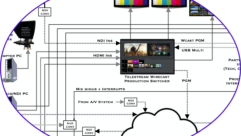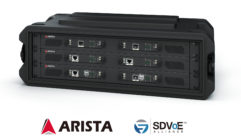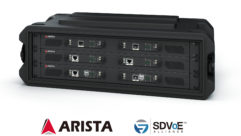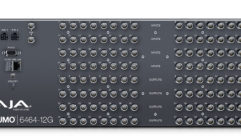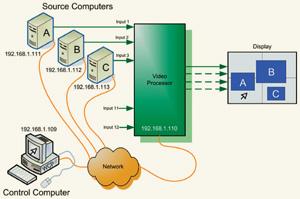

Integrating Source Control for Multiview Applications
Multi-input display processors for control rooms or other applications present video and information in a unified way.
Multi-input display processors for control rooms or other applications present video and information in a unified way. The processor can drive either a single-screen multiviewer or a multiscreen videowall and allows the end-user to select his sources and to size and position windows as they’re displayed.
An on-screen cursor may provide control of the processor and serve as a pointer. However conventional systems offer limited ways of controlling the source images themselves. What’s often missing is a way to blend control of the display space with control of the source inputs while at the same time supporting high-quality (non-IP-based) video.
A hybrid approach, using a combination of direct connection for video and IP for keyboard and mouse, may offer an optimal solution. In this scenario, video inputs are routed to the processor and synchronized with control signals that arrive over an IP network. In this way, the integrator is able to deliver high bandwidth for video and data transfers for keyboard and mouse signals.
Engineers at RGB Spectrum in Alameda, Calif., have come up with what the company calls Integrated Control System with KvM. In a description of the solution by RGB Spectrum CEO Bob Marcus, the display processor, control computer, and sources have unique IP addresses while a remote desktop agent is installed on each source system (see diagram). Passwords and public-key/private-key encryption between the source and control computer create a secure session, though Internet technologies such as Secure Sockets Layer (SSL) could also be used.
The system needs a user interface for controlling both display processor and source systems. Ideally it would comprise an on-screen cursor that can travel over the entire display, unified control of the processor and sources using a mouse, and a keyboard for data input. In RGB Spectrum’s implementation, switching between control of the video processor and the sources requires little more than a mouse click. On-screen visual cues, including the size and shape of the cursor, indicate whether it’s controlling the video processor or a source, based on its X and Y coordinates. The mouse controls a source computer when the cursor position resides within the window displaying its imagery. Outside of a window, the mouse controls the display processor.
In display processor mode, according to the company, the cursor could be used as a pointer and/or to control the size and placement of windows on the display, much as it would in a PC environment. When placing the cursor inside a window, the mouse click triggers a mode switch (and an indicative smaller cursor), allowing the end-user to operate the source displayed in the window.
Ultimately, such a hybrid solution could allow for high-quality video plus point-and-click control, making it a viable alternative to video over IP.



